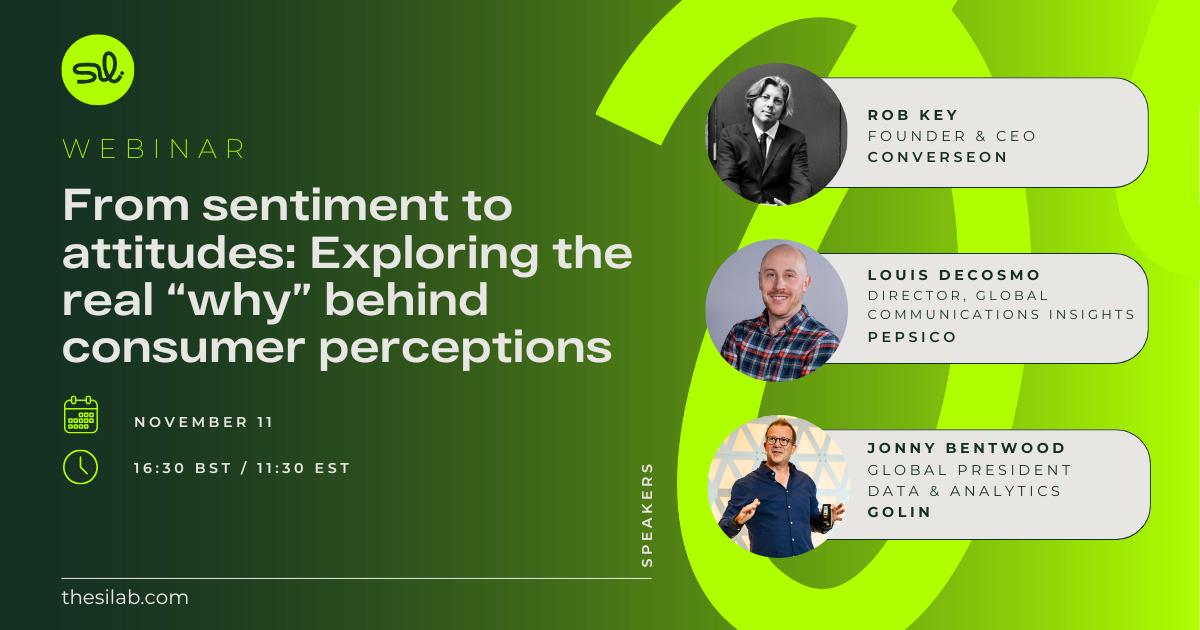
How Walmart has taken social intelligence beyond Comms
When it comes to setting up a social intelligence function within your organisation, there are a number of ways you can do it. Factors, such as the size of the team, the skills available, budget, and the remit of the team, will all help you decide the best approach.
We spoke to Aaron Bernstein, Senior Director of Insights and Advocacy at Walmart, to understand how it’s done there. Aaron built the social intelligence function here from scratch, around five years ago, and over this time, he’s learnt a lot about what works best for his team and the wider organisation.
A centralised team that supports the whole organisation
At Walmart, the social intelligence function is centralised. The team, which Aaron leads, sits within the Communications department. However, the data and insights they uncover aren’t limited to Comms challenges - they work with departments across the organisation. They’re mandated to be the broader business counsellor, providing intelligence that guides the rest of the organisation to make strategic decisions. According to Aaron, “We behave like an agency within the company, with the benefit that they don’t have to pay for us.”

How the Insights and Analytics team sit alongside the Comms team
As Aaron points out, the role Comms teams play within an organisation has evolved in recent years, “they’re now being tasked with broader strategic business issues, such as CSR, sustainability issues etc…the role of the communicator is more expansive, so they need better intelligence.”
And so, the Insights and Advocacy team at Walmart are focused on sharing data and intelligence that enables others in the organisation to:
- Identify key events, narratives and content topics
- Track emerging trends
- Understand the employee mindset
- Uncover reputational and business risks
- Assess consumer perception of the brand
This knowledge is shared across different departments in an accessible way: through automated alerts; instant notifications; real-time dashboards etc. For Aaron, making technology more accessible for employees is important. “It’s about the democratisation of technology.”
Walmart’s Insights and Advocacy team works across the business, both reactively - by responding to demands and specific questions - and proactively, to surface consumer insights. They produce a number of resources to help different departments to gather the information they need: daily intelligence briefs, weekly competitor reports, ad-hoc insights on trends.
Whilst the social intelligence function is centralised, there are a number of Analytics people embedded within the different communications verticals, e.g., crisis communications, in order to ensure the data and insights can be tailored to their specific needs.
Technology plays an important role
Communications, as a discipline, has often lacked maturity when it comes to adapting to innovation. And it’s only now that the industry is catching up, with the growth of ‘CommTech’ - software and tech tools that communicators can leverage to plan, execute and measure communications campaigns.
What doesn’t currently exist though, is a highly automated and customisable data and tech solution in one platform. As Aaron points out, “each organisation is different with different needs and objectives”, so it was important to build a social intelligence tech stack that works for Walmart. This includes licensing different technology and software platforms, and developing customised in-house technology, such as chat bots, automation systems etc.

An example of a Comms tech stack
Social data is unstructured data
When it comes to the type of data that Aaron’s team uses to gather intelligence and extract insight, it’s not limited to social media platforms. The team at Walmart instead works with publicly available data, i.e., anything that exists within the public online space. That includes anything from social, blogs, forums and news to economic reports, patents, academic papers and VC investments. This data can then be mixed with first-party data, often structured data, to reveal more complete insight.
Overcoming challenges to get leadership buy in
Whilst Aaron and his team have been successful in embedding the social intelligence function within Walmart they’ve faced a number of challenges. Mainly, that using social data to gain insight disrupts the conventional way of thinking. In more traditional organisations, when it comes to market research and consumer insight, there is still an emphasis on primary research (e.g. surveys) and business consultancies providing research.
And there’s nothing wrong with these forms of research - there is still a place for them. However, there are limitations or barriers that social intelligence can overcome. As Aaron points out, “it’s about showing that social intelligence is complementary to these services, and offers an alternative solution”. For example, reports from business consultancy firms can be very costly and take a long time to produce. With social intelligence, the insights provided may not be as in-depth and thoroughly researched, but they can be provided more quickly.
The social intelligence function at Walmart also has buy-in from leadership. This is something that many organisations struggle with - demonstrating the value of social intelligence to the CEO. At Walmart, Aaron identified that there was a desire from leadership for more innovation within the company. By demonstrating that communications can be as innovative as other departments (such as R&D) through the use of new technology and by taking a different approach to existing challenges, they were able to win them over.
Social intelligence feeds into long term business strategy
This has since led to the Insights and Advocacy team at Walmart being involved in more long-term, strategic business projects. Most recently, Aaron and his team have provided insights into how Walmart could be a more regenerative business, and grow sustainably. They harnessed millions of open source data points to generate insights. And, through the research, they were also able to uncover traits of successful, regenerative business practices.
In analysing the data, they were also able to “show how people are talking about social issues now compared to three or four years ago. The conversations are much more connected.” So whereas in the past, conversations about the environment and conversations about racism online were happening separately, there is now a lot more overlap in the types of people talking about both issues. This intelligence can be shared beyond the comms team, and can help to shape business strategy going forward.
There have been a number of other tangible outcomes of the strategy that Aaron and his team implemented. For example, through the Insights and Analytics technology ecosystem, they’re able to monitor customer feedback at scale, and improve Walmart's customer satisfaction and Net Promoter Scores by identifying the root causes of issues. One analysis revealed that long lines at the Money Center were driven by ATM issues, an issue that the team resolved after uncovering the insight.
They’ve also deployed ‘listening’ capabilities across beauty and other core consumable categories. They’re able to mine for information around things such as product availability, new and sustaining trends, shopper friction points, drivers of product consideration to identify actionable insights for the business.
Advice for those looking to set up their own social intelligence team
In the years setting up the Insights and Advocacy team at Walmart, Aaron learnt a lot. And, if there is any advice that he would give to people looking to do the same, it’s this:
- Be specific on what you want to achieve, and then prioritise which of those you want to target. So, yes, growth is important, but what specifically are the things you can do to achieve growth? And then which of those things should you focus on? Once you know this, you can work backwards to collect the relevant data and analyse it in a way that will provide you the answers you need.
- Look to build a social intelligence muscle within the organisation. And this should be built from a multidisciplinary workforce, providing a mix of the skills you need to be successful. This can be gained through a combination of recruitment, training and upskilling.
So, how you go about developing a social intelligence team that is trusted and respected by the wider business is going to look different for every organisation. The key is having clear objectives in mind for each social intelligence project, and creating a robust analysis framework.
This interview was recorded via LinkedIn Live, if you prefer to view on LinkedIn, click the button below.
View InterviewSee related content
.png)








